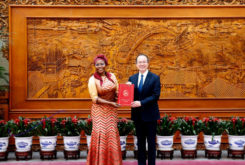Angola will need a new International Monetary Fund (IMF) program starting in 2022, after the expiration of the current one in the ammount of USD 3.7 billion, according to the Economist Intelligence Unit (EIU).
“Given Angola’s still weak fiscal position and high debt load, a new programme with the Fund will be agreed, beginning in 2022”, the EIU says in its most recent report on Angola.
Approved by the IMF Executive Board on December, 2018, Angola’s IMF programme will run until end-2021.
In September, the Executive Board of the IMF completed the third review of Angola’s economic program supported by an extended arrangement under the Extended Fund Facility (EFF), unlocking access to about USD1 billion, bringing total disbursements under the extended arrangement to about USD2.5 billion.
Angola’s three-year extended arrangement is worth about USD 3.7 billion, aiming at restoring external and fiscal sustainability, improving governance, and diversifying the economy to promote sustainable, private sector-led economic growth.
In completing the third review, the Executive Board also approved the authorities’ request for an augmentation of access under the EFF arrangement of 72 percent of Angola’s quota (about USD $765 million) to support authorities’ efforts to control the spread of COVID-19 pandemic, mitigate its economic impact, and persevere with the implementation of structural reforms.
In its most recent report, the EIU predicts that, following a contraction in 2020-21 owing to low global oil prices and weak investor sentiment, fixed investment—predominantly in the oil industry “will rise from 2022 as the government’s reform agenda bears fruit, although the non-oil economy will remain weak”.
Real GDP will contract by 0.1% in 2021, following a 3.2% decline in 2020 as oil production falls, the EIU forecasts.
Growth will average 4.9% in 2022-25 as higher global oil prices support greater economic activity and investment, “but high debt and limited reforms will weigh heavily”, it adds.
Annual inflation will average 19% in 2021 (from 21.8% in 2020), as US dollar inflows remain scarce; it will then moderate over remainder of the forecast period, averaging 11% in 2022-25, as dollar availability and export revenue rise gradually, the EIU forecasts.
The current-account deficit will widen in 2021 to 7.1% of GDP (from an estimated 2.4% of GDP in 2020) as imports increase. The deficit will narrow steadily to 5% of GDP by 2025 as exports gradually pick up.
In the report, the EIU revised the currency forecast for 2021 to an average of Kz691.7:USD1 (from Kz658.9:USD1 previously) “as the kwanza continues to depreciate sharply, owing to a shortage of US dollars as oil exports drop”.
Angola´s economy is set to stabilize next year, after five consecutive years of recession, according to an analysis of the State Budget for 2021 by Eaglestone Securities.




